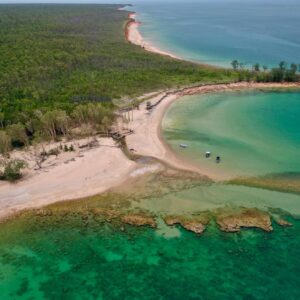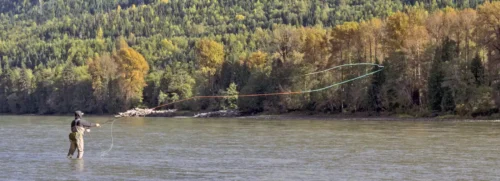Australia’s Cape York: Target Species & What To Throw At Them
by
Justin Miller
This is a list and profile of the most sought after gamefish we encountered on the West Coast of Cape York, in the Gulf of Carpentaria, Australia. It is the most diverse place I have ever fished, the total list of species we encountered was actually unbelievable, many of which you can’t find anywhere else on the planet. To say Australia is unique is a gross understatement. It stands alone, literally and figuratively. A place evolution got a little sideways on and bent the rules that everyone else had to play by… And I mean the best part of sideways.
Here is a list of the most sought after target species that we went hunting for:

Barramundi (Lates calcarifer)– Barra’s are Australia’s favorite fish. The Aussie’s are crazy for them. If you are Australian, you are part of the “One Meter Club”, or you’re not, no matter who you are. Barramundi are super diverse. They love being up in the estuaries and creeks, tucked in the mangroves, but they can go out into the ocean along the coast as well, not unlike giant Snook. They have also been introduced into tons of reservoirs in Australia where they can get massive, so everyone has access to them… They are like Largemouth Bass in the USA… They are just a cultural phenomenon… And on Cape York, and specifically the estuary that the guides at Weipa Sports Fishing live on, they get enormous! Equipment & Flies: Basically, you are throwing a baby tarpon rig. A 9wt or 10wt is perfect, with a 6ft level leader of 40lbs Fluorocarbon. You could throw a floating line, but I preferred a clear tip intermediate. They have developed some flies specific for Barramundi, like the Pink Thing and the Barra Bunny, but they’ll eat a bunch of the stuff that you already have in your box, like Clousers, Deceivers, Half and Half’s and Puglisi flies.
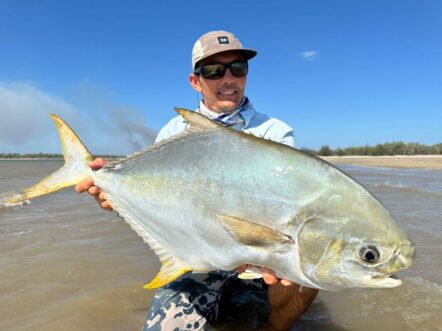
Anak Permit (Giant Oystercracker, Trachinotus anak Ogilby) – The Anak Permit (T. Anak) is one of the rarest of the targetable Permit (Trachinotus) species in the Permit Grand Slam. If you are a permit junky like we are, Anak are on your radar, and this is the best place (actually, Australia is pretty much the only place) on earth to chase them. They look very similar to Blochii, the standard and widely distributed “Indo-Pacific Permit”, with the yellow tint, but they have kind of a larger bulbous snout, and can get really big, compared to Blochii, with record specimens topping out over 50 lbs! They still do the permit thing though, tailing for crabs in shallow water, and driving anglers crazy with their skittish antics, picky eating habits and generally just giving us the fin… Which is what makes us put them on such a tall pedestal! Equipment & Flies: All of the flats species (Permit, Blue Bastards, Tuskies) on the coast of the Gulf of Carpentaria are targeted with the same rig as I fish on the flats in the Caribbean for Permit, which is super convenient. None of this 4 rods, in 4 different line weights, with crazy different leaders and flies… I threw a 9wt or 10wt rod with an aggressively tapered full floating line, like the Scientific Angler Grand Slam. We used 10+ foot tapered fluorocarbon leaders in 17-20lbs, for all flats species as well. Tan Alphlexo crabs with yellow legs were a favorite, but I mostly threw my favorites from back home, tan or white Casa Blanca crabs.
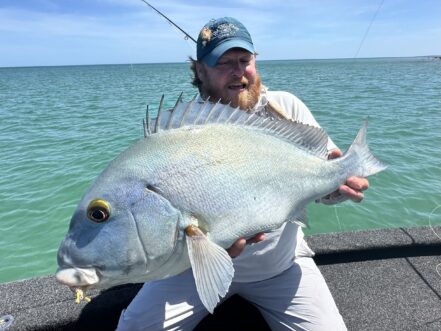
Blue Bastard (Plectorhinchus caeruleonothus) – Well, they definitely got the most Australian name ever… Even its official Latin scientific name, Plectorhinchus Caeruleonothus, means “Blue Bastard”! But, they got it for good reason! Blue Bastards have exploded into the saltwater fly fishing world as a trophy species to stalk on the flats. They love coral rubble more than open white sand, and their stubbornness to take the fly, and then their bulldozer-like fighting style, which often results in disaster in the coral they love, has given them their infamous reputation… and name! Equipment & Flies: The same rig as we threw for the Anak Permit!
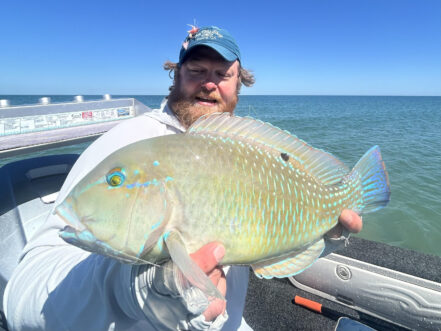
Black Spot Tuskfish (Choerodon schoenleinii) – Tusky’s, as they are affectionately called, also have the nickname “The Tractor Of The Flats”. They don’t get anywhere close to as big as Blue Bastards or Permit, but they are extremely difficult to stop as they defiantly take you back into the corral. They look like a mini Parrotfish, brightly colored a vibrant electric blue when they are mature, they are easy to spot, but still can be finicky about taking a fly. Get it right in front of them, let it sink all the way, then bump it, just make it move a little, No big or fast strips, they won’t chase it far. If they do take it, get ready for a surprisingly savage battle for what you thought you were getting into! Equipment & Flies: Again, the same rig as we threw for the Anak Permit and Blue Bastards, but they did like shrimp patterns as well, after refusals on the crab! (I bet the others would too…)
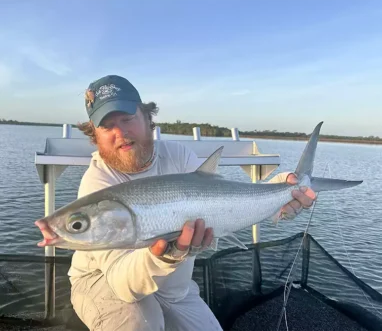
Milkfish (Chanos chanos) – These things are incredible! They are the only oddball that doesn’t eat the streamer rig or the crab rig. Filter feeders, they are typically targeted out in deep water off the shelf, in big schools. They feed into the current, rolling with their mouths open, skimming algae off of the surface. You just cast in front of a big mass of them and keep the line taught, strip if the boat was drifting into them, just to keep tension, not to move the fly… algae doesn’t swim! It is harder than it sounds! In Cape York we found Milky’s doing this same thing, but in the estuary in much shallower water, on falling tides, facing upstream and feeding on algae as it drifted by. They looked like trout as they sipped the algae off the surface, in the current! Without being able to dive like they do out in the deep, they would run a hundred yards at a time, absolutely smoking your reel! They are so savage that only recently, after actually testing their blood after a fight, the theory that Milkfish don’t build lactic acid was debunked! They never burn out, so we all just assumed that they couldn’t! Fights take forever!! They are pound for pound the strongest fish I have ever fought. They’d drown an equal size tarpon, if tied tail to tail. The Milky’s we found ranged in size from 10 to 40 pounds, maybe. The beginning of the fight is spectacular with them launching out of the water as they burn away. The other thing that makes them so difficult to deal with is that they have a soft mouth (algae eater) and you only have a #6 hook and a 20lbs leader keeping you connected. Not a great recipe for a fish this big and crazy… So, keep a slightly looser drag for the initial mayhem, but don’t get overspooled and backlashed! Then you can tighten up a bit and get ready for the next half hour of tug-o-war. Be careful not to pull too hard though! It’s a super fine line… Pull too hard and you will rip the hook right out of their soft lips, or break the leader… But if you don’t pull hard enough, you will be in the fight for over an hour, no exaggeration! Remember, they don’t get tired! Be very careful, knuckle busters are an instant game over, you will pop the leader every time. Equipment & Flies: 9wt or 10wt with floating line, 20lbs tapered fluoro leader. Easy to convert your Permit / Bastard rod with just a fly change. There is only one… THE Milky Dream.
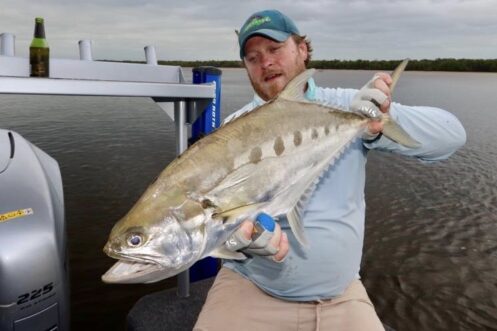
Queenfish (Scomberoides commersonnianus) – Queenies are absolutely ferocious! If you see birds working bait, you can bet your last dollar that there is going to be a gang of Queenies beating them up from below. There will be other species as well, but you will need to catch every Queenie down there before you start hooking the Trevally and Tuna… The Queenie is just quicker. They are awesome fighters too, they smash the fly on a fast strip and then jump and shake, like a tarpon. They might be the perfect gamefish… There are actually 3 different species of Queenfish and you will find them up in the estuary and mangroves as well as out in the deep water off the shelf. Equipment & Flies: 10wt and a Half & Half, Clouser, or Deceiver or similar baitfish streamer. Same rig as we threw for Barra’s.
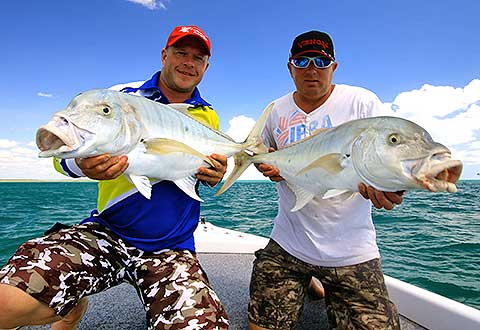
Golden Trevally ( Gnathanodon speciosus) – Goldie’s can do anything! You can find them tailing on crabs in shallow water one minute and then find them out bashing bait with the Queenies in deep water the next! It is incredible… There are not many fish that are equally comfortable in both roles. Maybe a Striper sometimes?! Redfish to a degree… and you hear about that one guy that got a permit on a streamer once, or GT’s eating crabs on rays from time to time, but usually, fish will be a tailer or a predator… Golden Trevally do both with regularity and are super fun to target in either scenario. Equipment & Flies: Same rig as we threw for Barra’s… Or Permit… Depends on where you find them!!

Giant Trevally (Caranx ignobilis) – Tea Leaf (Brassy) / Big Eye / Diamond Trevally – The variety of Trevally species swimming Cape York’s waters is impressive. Giant Trevally, GT for short, but commonly referred to as Geet’s, are by far the most famous, mostly because they can get enormous and they hunt in shallow water. I saw a couple monsters that would fit that bill, but I never got any good shots at them. Definitely not enough to necessitate packing around a 12wt, like in the Seychelles. But, we did land plenty of GT’s in the 10-20lbs range, as well as Tea Leaf Trevally and Big Eye Trevally of similar size. Mostly we found them feeding all together in deeper water chasing bait. Diamond Trevally are different though… They are crazy looking, absolutely gorgeous with pearly iridescent, mirrored skin and a weird diamond shaped head with a dorsal comb like a Roosterfish, but even longer and stringier. They are rare, but I managed to catch one feeding off the back of a ray, on a crab! Super cool! Equipment & Flies: Same rig as we threw for Barra’s… Unless they are on ray’s, then it’s crabs and shrimp!
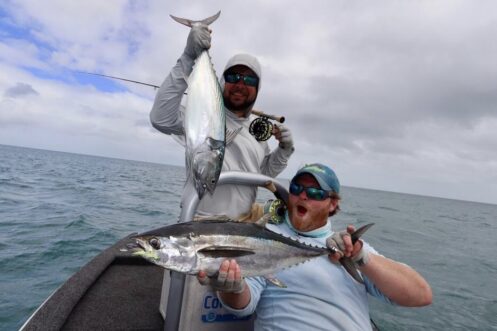
Longtail / Mack Tuna (Thunnus tonggol) – Tuna are just absolute missiles. They are just so fast and strong, they will wear you out…It is a special thing to see them cutting a bait ball to ribbons under diving birds. And if they stay on the bait after you pull up and you get a cast into the massacre, you better hold on, there are not many fish that will run as hard as a Tuna will… There are 2 main species you will encounter most often at Cape York. You want the Longtail, because they are delicious and the guide will cut its gills and serve sashimi for an appetizer that night! The Mack’s rip just as hard, but are apparently oily and nobody keeps them… But we are here for the fight! Equipment & Flies: Same rig as we threw for Barra’s! Just strip it as fast as you bloody can!

Mudskipper (Periophthalmus argentilineatus Valenciennes) – One of my favorite fish encountered in Australia was the Mudskipper. I had never seen one before and they were blowing my mind. At low tide, mud banks become exposed below the mangroves and above the water line. These trippy-looking fish would be sitting up on the mud, literally feet away from the water line, dragging themselves along with their perfectly evolved hinged pectoral fins. They are bizarre-looking, like they fell out of the ugly tree and hit every branch on the way down. Only maybe 6 inches long, cartoonish eyes poking up off the top of their flat heads and their crazy oversized pectorals propelling them forward through the terrestrial world where fish have no business being… they were absolutely mesmerizing. I asked my guide, Jack, if he’d ever tried to catch one. Answering with a cockeyed glance he said no, but that he’d seen them kind of charge at lures that were cast too far, with the angler then dragging their offering over the mud back into the water. I said we should try to catch one on a fly. The look I got back in reply should have been a deterrent, but I pushed forward. At lunch, aboard the mothership and with the full crew, I laid out my plan. The response was mostly what you’d expect, giggles and dismissal, mostly guys just blowing it off as some wild goose chase and a waste of time. But my buddy BWise said he’d give it a shot on his boat, too, so I was pumped that I got at least one other guy stoked about this misadventure! After lunch, Jack realized it was no longer a joke and he got locked in with me for a proper mudskipper hunt. When the tide got right we started stalking the mud banks and found a few of our desired new target species sitting up on a point a few feet above the water line. I tied on a sparse little baitfish pattern about three inches long that penciled right down and just slunk its way through the mud as I inched it towards the water’s edge. The first cast was about a three-foot permit lead, but the little mudskipper reacted and moved about six inches towards the fly! We freaked out that we got it to move at all! The next cast was a bit tighter and our target closed in, but didn’t commit. I then got in a shot about two feet past him, the leader only four inches in front of his face. I slow-stripped the fly right in front of him and he jumped all over it! I strip set on him like he was a tarpon, launching him into the water towards us! We all lost it, Jack yelling for me to strip out the slack and keep the rod bent, like it was some monster Barra, but I was casting a 10wt, for a fish that weighed less than my reel. Somehow I managed to strip that old mudskipper to the boat and we hauled all three ounces of him over the gunnel, the crew in absolute ecstasy that it had all come together. Seriously, I think I was as excited about landing that mudskipper as any permit or steelhead that I’ve ever landed. Pure joy in the boat and an absolute trophy fish in my book.
Back at the ship as we all returned from another epic afternoon, BWise exclaimed, “We landed a Mudskipper!” as he flashed an iPhone picture of himself holding one. I, of course, am ecstatic for him yelling, “Hell yes, brother!! Me too!” He and Leroy, his guide, look at each other questioningly and say, “Really?” I show him the picture and launch our story and then ask how their deal went down. BWise cracks and says they cheated, thinking that actually getting one to eat on the fly would be impossible. Leroy tossed a bait fish throw-net on one, perpetrating an elaborate hoax to pull one over on me and everybody else! The fallout of the conspiracy will live in infamy for generations. Despite their treachery, the whole situation is to this day one of the most fun fly fishing shenanigans that I have ever been fortunate to be a part of! Equipment & Flies: Same rig as we fished for Barra’s! HAHA! But, we did change to a sparse little streamer that was way more their size, only about 2”-3” long and slinky.
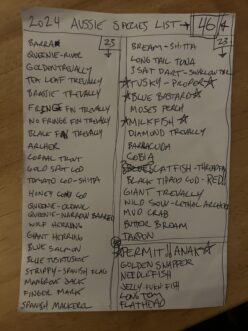
Australia is not a “Bucket List” trip. The minute you get on the plane home, you will start thinking about how and when you are going to get back… Writing this, I am haunted by it.
The diversity of the fishery was absolutely incredible. As a group, we landed a total of 46 different species. On top of all of the target fish I’ve detailed, there are tons of small little weird things that dart out of the coral, and they become a defining part of this amazing fishery. The guides would just refer to them collectively as Shitta’s, but each evening I made the guides sit down and tell us the real names of each of the different species’. We kept a detailed list, looking up every one of them in the fish book they had on the boat, to verify. The whole group was super into it and would crowd around the table as we added the day’s new species, every night. It was a super cool thing to do, both for our own personal knowledge, but to also give those “meaningless” fish actual meaning and value. Every one of them got put on the list, all equally important, no matter how Shitta they were. It was awesome…
Australia is not a “Bucket List” trip. The minute you get on the plane home, you will start thinking about how and when you are going to get back… Writing this, I am haunted by it.
Contact Justin Miller at (800) 669-3474 | (530) 222-3555 | justin@theflyshop.com to learn more about Australia and the fish Down Under.

